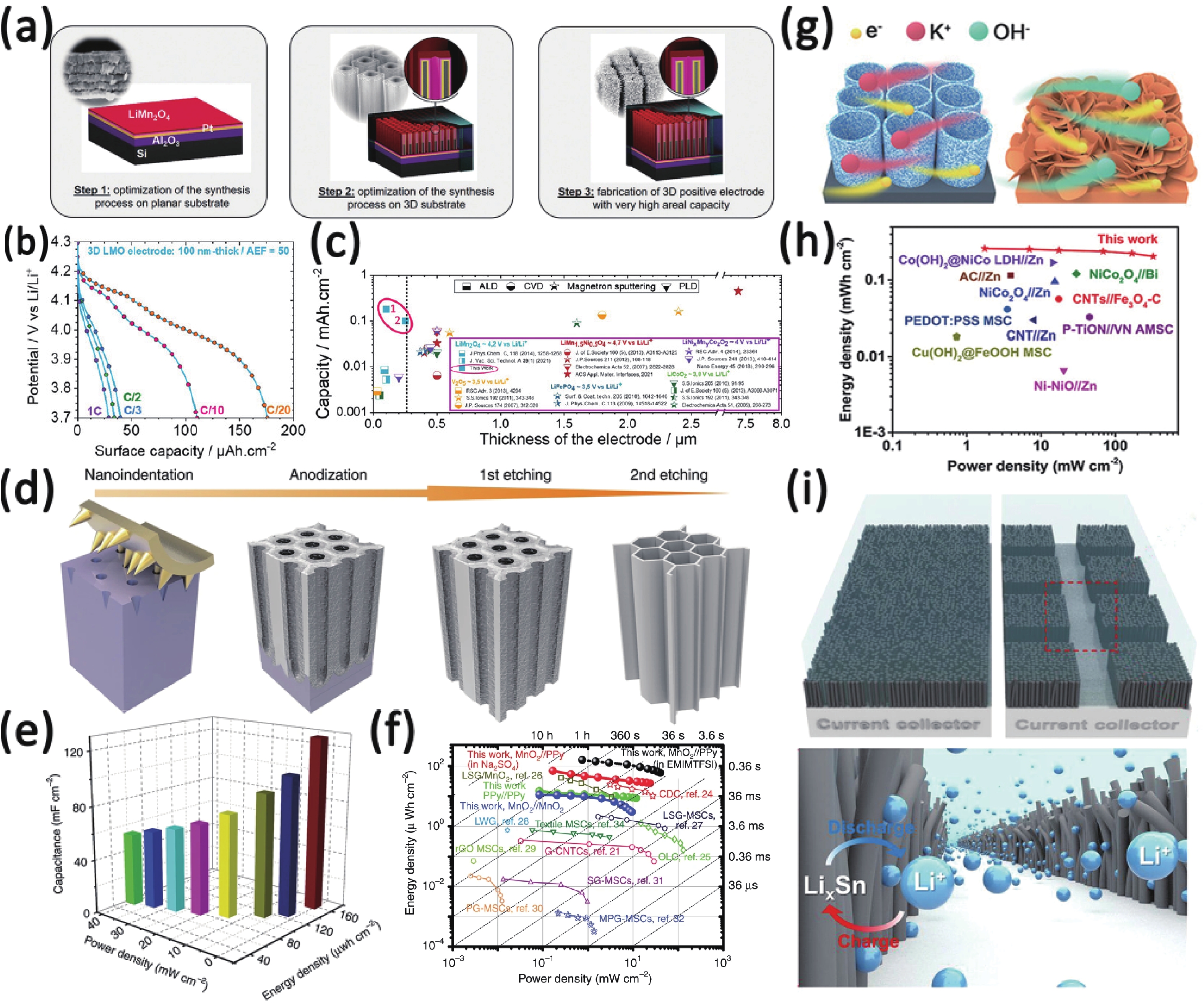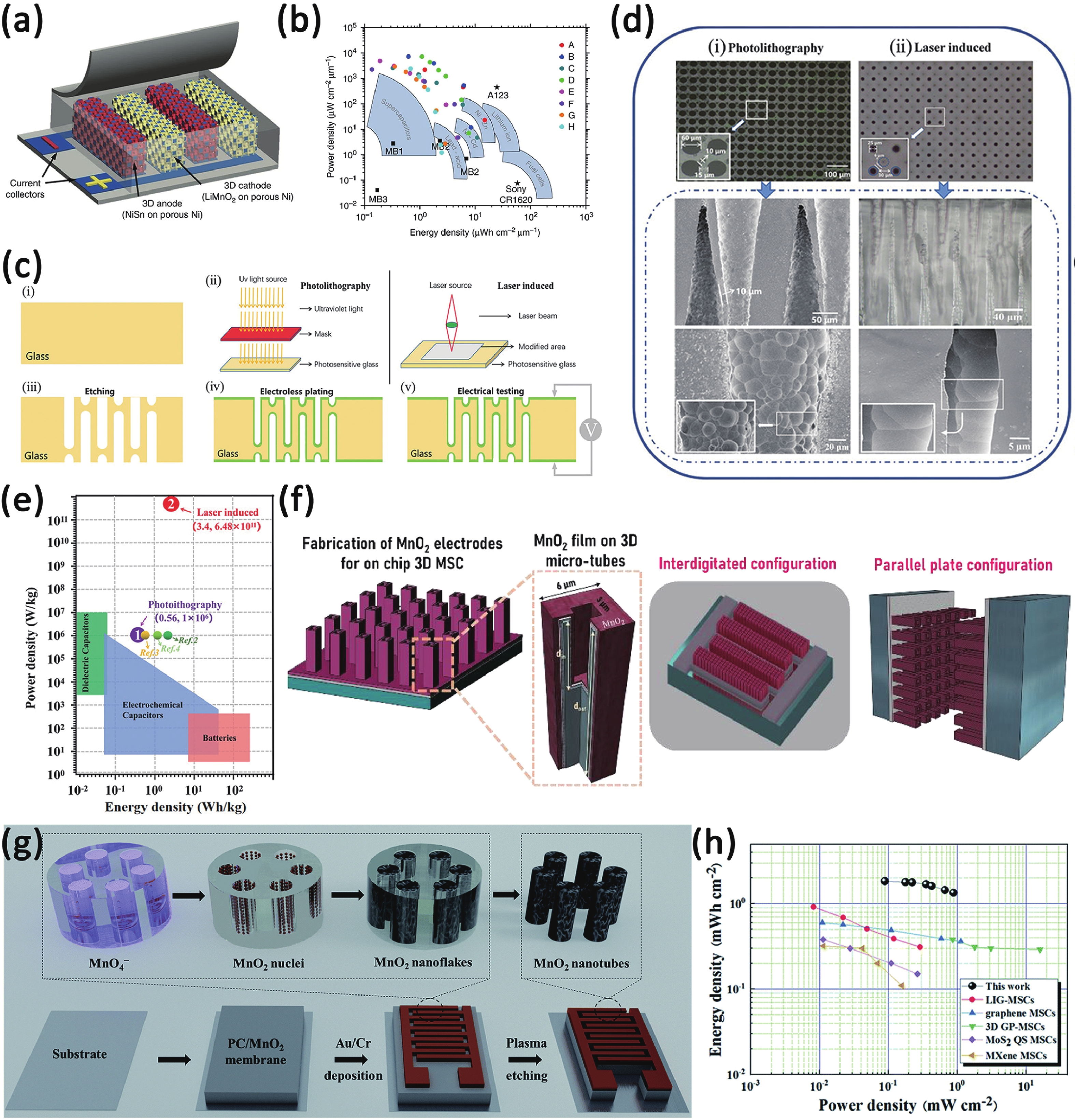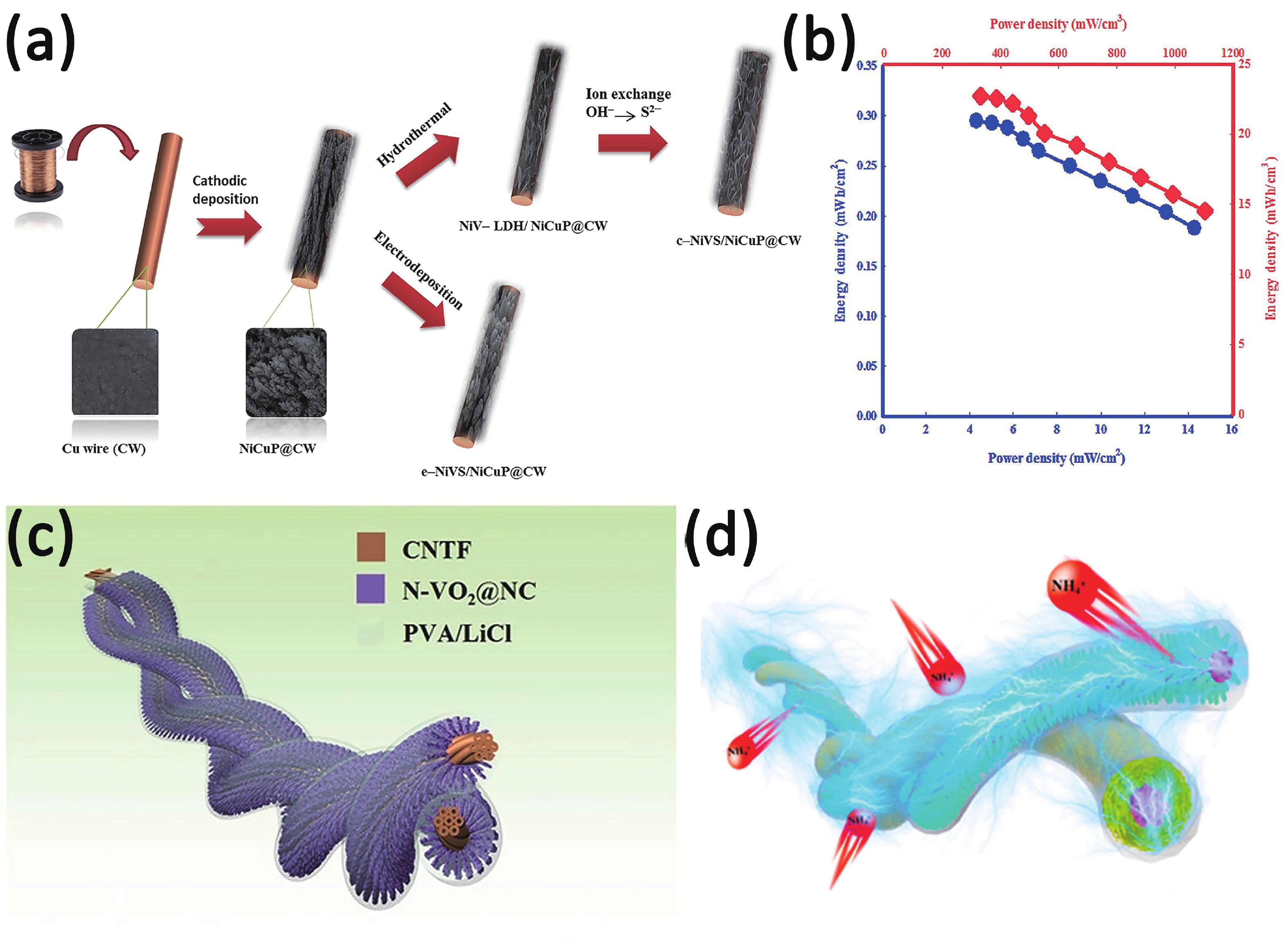| Citation: |
Xin Chao, Chengzhan Yan, Huaping Zhao, Zhijie Wang, Yong Lei. Micro-nano structural electrode architecture for high power energy storage[J]. Journal of Semiconductors, 2023, 44(5): 050201. doi: 10.1088/1674-4926/44/5/050201
****
X Chao, C Z Yan, H P Zhao, Z J Wang, Y Lei. Micro-nano structural electrode architecture for high power energy storage[J]. J. Semicond, 2023, 44(5): 050201. doi: 10.1088/1674-4926/44/5/050201
|
Micro-nano structural electrode architecture for high power energy storage
DOI: 10.1088/1674-4926/44/5/050201
More Information
-
References
[1] Li C, Li J, Huang Y, et al. Recent development in electronic structure tuning of graphitic carbon nitride for highly efficient photocatalysis. J Semicond, 2022, 43, 021701 doi: 10.1088/1674-4926/43/2/021701[2] Ma M, Huang Y, Liu J, et al. Engineering the photoelectrochemical behaviors of ZnO for efficient solar water splitting. J Semicond, 2020, 41, 091702 doi: 10.1088/1674-4926/41/9/091702[3] Sha M, Zhao H, Lei Y. Updated insights into 3D architecture electrodes for micropower sources. Adv Mater, 2021, 33, 2103304 doi: 10.1002/adma.202103304[4] Huang Y, Liu J, Deng Y, et al. The application of perovskite materials in solar water splitting. J Semicond, 2020, 41, 011701 doi: 10.1088/1674-4926/41/1/011701[5] Xia Q, Zan F, Xu J, et al. All-solid-state thin film lithium/lithium-ion microbatteries for powering the Internet of Things. Adv Mater, 2022, 35, 2200538 doi: 10.1002/adma.202200538[6] Ma J, Zheng S, Das P, et al. Sodium ion microscale electrochemical energy storage device: present status and future perspective. Small Structures, 2020, 1, 2000053 doi: 10.1002/sstr.202000053[7] Jiang Q, Lei Y, Liang H, et al. Review of MXene electrochemical microsupercapacitors. Energy Stor Mater, 2020, 27, 78 doi: 10.1016/j.ensm.2020.01.018[8] Zhao C, Xu B, Wang Z, et al. Boron-doped III–V semiconductors for Si-based optoelectronic devices. J Semicond, 2020, 41, 011301 doi: 10.1088/1674-4926/41/1/011301[9] Zhang P, Yang S, Xie H, et al. Advanced three-dimensional microelectrode architecture design for high-performance on-chip micro-supercapacitors. ACS Nano, 2022, 16, 17593 doi: 10.1021/acsnano.2c07609[10] Yuan Y, Jiang L, Li X, et al. Laser photonic-reduction stamping for graphene-based micro-supercapacitors ultrafast fabrication. Nat Commun, 2020, 11, 6185 doi: 10.1038/s41467-020-19985-2[11] Kim S W, Hwang J, Ha S J, et al. Ultrathin MoS2 flakes embedded in nanoporous graphene films for a multi-functional electrode. J Mater Chem A, 2021, 9, 928 doi: 10.1039/D0TA10397G[12] Sun P, Li X, Shao J, et al. High-performance packaged 3D lithium-ion microbatteries fabricated using imprint lithography. Adv Mater, 2021, 33, 2006229 doi: 10.1002/adma.202006229[13] Hallot M, Nikitin V, Lebedev O I, et al. 3D LiMn2O4 thin film deposited by ALD: a road toward high-capacity electrode for 3D li-ion microbatteries. Small, 2022, 18, 2107054 doi: 10.1002/smll.202107054[14] Lei Z, Liu L, Zhao H, et al. Nanoelectrode design from microminiaturized honeycomb monolith with ultrathin and stiff nanoscaffold for high-energy micro-supercapacitors. Nat Commun, 2020, 11, 299 doi: 10.1038/s41467-019-14170-6[15] Zhu Z, Kan R, Wu P, et al. A durable Ni-Zn microbattery with ultrahigh-rate capability enabled by in situ reconstructed nanoporous nickel with epitaxial phase. Small, 2021, 17, 2103136 doi: 10.1002/smll.202103136[16] Kim M, Kang S K, Choi J, et al. Patterning design of electrode to improve the interfacial stability and rate capability for fast rechargeable solid-state lithium-ion batteries. Nano Lett, 2022, 22, 10232 doi: 10.1021/acs.nanolett.2c03320[17] Wang L, Tang Y, Li Y, et al. Multifunctional integrated interdigital microsupercapacitors and self-powered iontronic tactile pressure sensor for wearable electronics. ACS Appl Mater, 2022, 14, 47136 doi: 10.1021/acsami.2c15117[18] Zhang J, Zhang G, Zhou T, et al. Recent developments of planar micro-supercapacitors: fabrication, properties, and applications. Adv Funct, 2020, 30, 191000 doi: 10.1002/adfm.201910000[19] Wei W, Ouyang S, Zhang T. Perylene diimide self-assembly: From electronic structural modulation to photocatalytic applications. J Semicond, 2020, 41, 091708 doi: 10.1088/1674-4926/41/9/091708[20] Zhao C, Wang Z. An efficient entangled-photon source from semiconductor quantum dots. J Semicond, 2020, 41, 010401 doi: 10.1088/1674-4926/41/1/010401[21] Pikul J H, Gang Zhang H, Cho J, et al. High-power lithium ion microbatteries from interdigitated three-dimensional bicontinuous nanoporous electrodes. Nat Commun, 2013, 4, 1732 doi: 10.1038/ncomms2747[22] Fang Z, Gao L, Chen H, et al. 3D interdigital electrodes dielectric capacitor array for energy storage based on through glass vias. Adv Mater Technol, 2022, 7, 2101530 doi: 10.1002/admt.202101530[23] Bounor B, Asbani B, Douard C, et al. On chip MnO2-based 3D micro-supercapacitors with ultra-high areal energy density. Energy Stor Mater, 2021, 38, 520 doi: 10.1016/j.ensm.2021.03.034[24] Li F, Hu A, Zhao X, et al. On-chip high-energy interdigital micro-supercapacitors with 3D nanotubular array electrodes. J Mater Chem A, 2022, 10, 14051 doi: 10.1039/D2TA02660K[25] Cao Y, Zhang H, Zhang Y, et al. Epitaxial nanofiber separator enabling folding-resistant coaxial fiber-supercapacitor module. Energy Stor Mater, 2022, 49, 102 doi: 10.1016/j.ensm.2022.03.011[26] Mo F, Liang G, Huang Z, et al. An overview of fiber-shaped batteries with a focus on multifunctionality, scalability, and technical difficulties. Adv Mater, 2020, 32, 1902151 doi: 10.1002/adma.201902151[27] Ma X, Jiang Z, Lin Y. Flexible energy storage devices for wearable bioelectronics. J Semicond, 2021, 42, 101602 doi: 10.1088/1674-4926/42/10/101602[28] Zhu H, Sha M, Zhao H, et al. Highly-rough surface carbon nanofibers film as an effective interlayer for lithium–sulfur batteries. J Semicond, 2020, 41, 092701 doi: 10.1088/1674-4926/41/9/092701[29] Naderi L, Shahrokhian S. Nickel vanadium sulfide grown on nickel copper phosphide Dendrites/Cu fibers for fabrication of all-solid-state wire-type micro-supercapacitors. Chem Eng J, 2020, 392, 124880 doi: 10.1016/j.cej.2020.124880[30] Guo J, Li L, Luo J, et al. Polypyrrole-assisted nitrogen doping strategy to boost vanadium dioxide performance for wearable nonpolarity supercapacitor and aqueous zinc-ion battery. Adv Energy Mater, 2022, 12, 2201481 doi: 10.1002/aenm.202201481[31] Han L, Luo J, Zhang R, et al. Arrayed heterostructures of MoS2 nanosheets anchored TiN nanowires as efficient pseudocapacitive anodes for fiber-shaped ammonium-ion asymmetric supercapacitors. ACS Nano, 2022, 16, 14951 doi: 10.1021/acsnano.2c05905[32] Wang Z, Ni J, Li L, et al. Theoretical simulation and modeling of three-dimensional batteries. Cell Rep, 2020, 1, 100078 doi: 10.1016/j.xcrp.2020.100078[33] Miyamoto K, Broderick S, Rajan K. Three-dimensional microbattery design via an automatic geometry generator and machine-learning-based performance simulator. Cell Rep, 2021, 2, 100504 doi: 10.1016/j.xcrp.2021.100504[34] Yin Z, Hu M, Liu J, et al. Tunable crystal structure of Cu–Zn–Sn–S nanocrystals for improving photocatalytic hydrogen evolution enabled by copper element regulation. J Semicond, 2022, 43, 032701 doi: 10.1088/1674-4926/43/3/032701[35] Nasori N, Dai T, Jia X, et al. Realizing super-long Cu2O nanowires arrays for high-efficient water splitting applications with a convenient approach. J Semicond, 2019, 40, 052701 doi: 10.1088/1674-4926/40/5/052701[36] Liu J, Wang Z, Lei Y. A close step towards industrialized application of solar water splitting. J Semicond, 2020, 41, 090401 doi: 10.1088/1674-4926/41/9/090401[37] Li Y, Xiao S, Qiu T, et al. Recent advances on energy storage microdevices: From materials to configurations. Energy Stor Mater, 2022, 45, 741 doi: 10.1016/j.ensm.2021.12.026Getrightsandcontent[38] Li L, Hu C, Liu W, et al. Progress and perspectives in designing flexible microsupercapacitors. Micromachines, 2021, 12, 1305 doi: 10.3390/mi12111305 -
Proportional views

§Xin Chao and Chengzhan Yan contributed equally to this work and should be considered as co-first authors.





 DownLoad:
DownLoad:












 Xin Chao:got her B.S. degree from Henan University of Technology in 2021. Now she is a M.S. student at Shanghai University. Her research interests focus on the construction and functionalization of nanomaterials for energy storage devices
Xin Chao:got her B.S. degree from Henan University of Technology in 2021. Now she is a M.S. student at Shanghai University. Her research interests focus on the construction and functionalization of nanomaterials for energy storage devices Chengzhan Yan:received his M.S. degree in chemistry from Wenzhou University in 2020. He is currently a PhD student under the supervision of Prof. Yong Lei at the Technical University of Ilmenau in Germany. His research interests focus on designing and synthesizing nanomaterials for electrochemical energy storage
Chengzhan Yan:received his M.S. degree in chemistry from Wenzhou University in 2020. He is currently a PhD student under the supervision of Prof. Yong Lei at the Technical University of Ilmenau in Germany. His research interests focus on designing and synthesizing nanomaterials for electrochemical energy storage Huaping Zhao:obtained his PhD in Materials Science from the State Key Laboratory of Crystal Materials of Shandong University in 2007. Following two years of postdoctoral research at the Institute of Chemistry (Chinese Academy of Sciences, 2007–2009), he was employed as a scientist by the University of Muenster from 2009 to 2011. Since 2012, he has been a senior scientist (permanent) in Prof. Yong Lei’s group at the Technical University of Ilmenau, Germany. His current research focus is the design and fabrication of functional nanostructures for energy storage and conversion
Huaping Zhao:obtained his PhD in Materials Science from the State Key Laboratory of Crystal Materials of Shandong University in 2007. Following two years of postdoctoral research at the Institute of Chemistry (Chinese Academy of Sciences, 2007–2009), he was employed as a scientist by the University of Muenster from 2009 to 2011. Since 2012, he has been a senior scientist (permanent) in Prof. Yong Lei’s group at the Technical University of Ilmenau, Germany. His current research focus is the design and fabrication of functional nanostructures for energy storage and conversion Zhijie Wang:received his B.S. degree in 2004 from Zhejiang University and Ph.D. degree in 2009 from the Institute of Semiconductors, Chinese Academy of Sciences. After four years of postdoc research in the University of Wyoming and the University of Michigan, he worked as a senior scientist and a junior group leader at the Ilmenau University of Technology (Germany) in the 3D Nanostructuring Group of Prof. Yong Lei since 2013. He is currently a professor in the Institute of Semiconductors, Chinese Academy of Sciences. His research interest includes nanomaterials, nano-devices, energy-related sciences, surface science and photoelectron chemistry
Zhijie Wang:received his B.S. degree in 2004 from Zhejiang University and Ph.D. degree in 2009 from the Institute of Semiconductors, Chinese Academy of Sciences. After four years of postdoc research in the University of Wyoming and the University of Michigan, he worked as a senior scientist and a junior group leader at the Ilmenau University of Technology (Germany) in the 3D Nanostructuring Group of Prof. Yong Lei since 2013. He is currently a professor in the Institute of Semiconductors, Chinese Academy of Sciences. His research interest includes nanomaterials, nano-devices, energy-related sciences, surface science and photoelectron chemistry Yong Lei:is Professor and the Head of Group (Chair) of Applied Nano-physics at Technical University of Ilmenau in Germany. He started to work in Germany as an Alexander von Humboldt Fellow at Karlsruhe Institute of Technology in 2003. From 2006 he worked at University of Muenster as a group leader and Junior Professor. In 2011, he joined the Technical University of Ilmenau as a Chair Professor. His research focuses on template-based nanostructuring, energy conversion and storage devices, and optoelectronic applications of functional nanostructures. He received a few prestigious funding in Europe and Germany including two European Research Council Grants. Prof. Lei is Advisory Board Member or Associate Editor of a few journals such as Advanced Energy Materials, Energy & Environmental Materials, InfoMat and Carbon Energy
Yong Lei:is Professor and the Head of Group (Chair) of Applied Nano-physics at Technical University of Ilmenau in Germany. He started to work in Germany as an Alexander von Humboldt Fellow at Karlsruhe Institute of Technology in 2003. From 2006 he worked at University of Muenster as a group leader and Junior Professor. In 2011, he joined the Technical University of Ilmenau as a Chair Professor. His research focuses on template-based nanostructuring, energy conversion and storage devices, and optoelectronic applications of functional nanostructures. He received a few prestigious funding in Europe and Germany including two European Research Council Grants. Prof. Lei is Advisory Board Member or Associate Editor of a few journals such as Advanced Energy Materials, Energy & Environmental Materials, InfoMat and Carbon Energy



